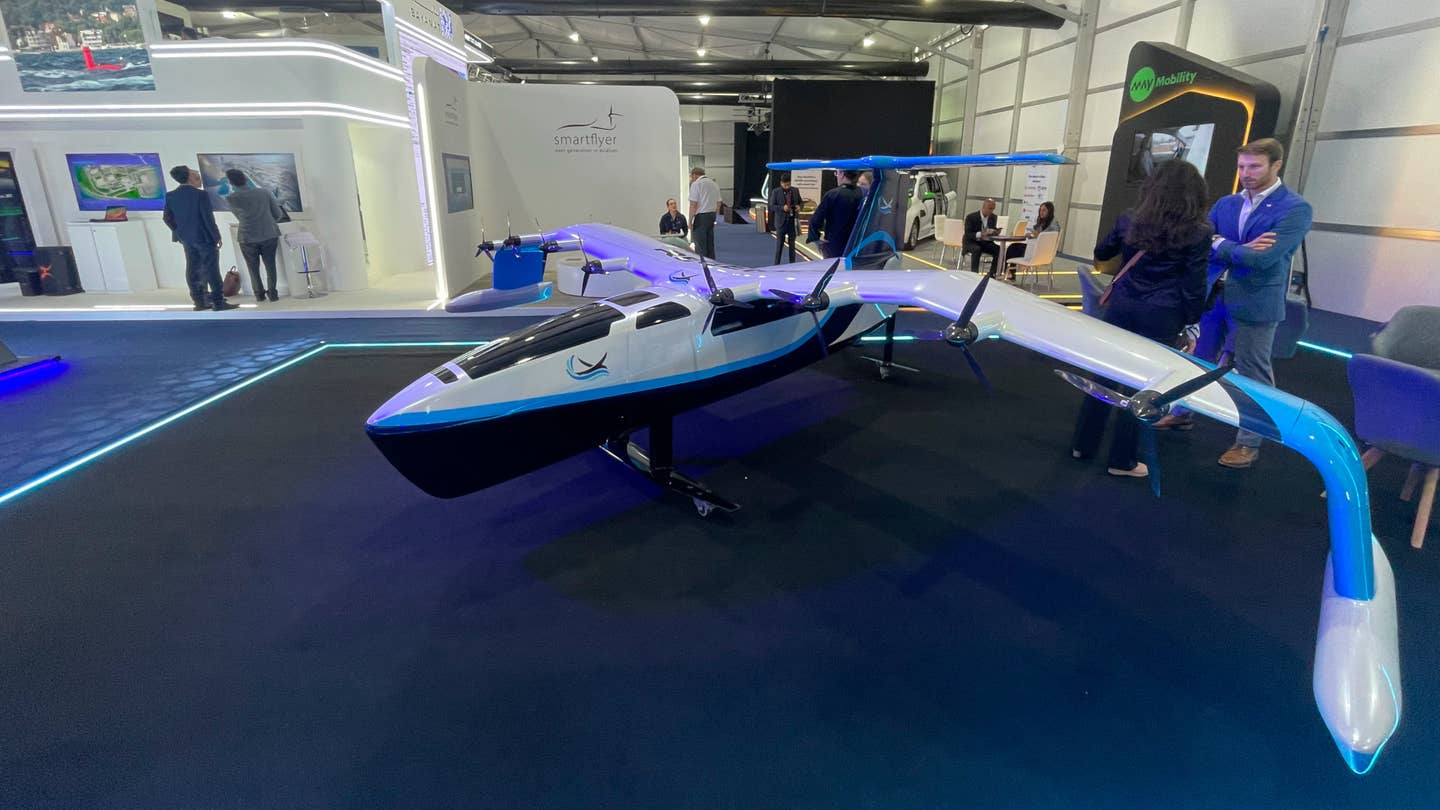Regent Eyes Electric Seaglider Service in Abu Dhabi
The manufacturer will collaborate with the Abu Dhabi Investment Office and the Emirate’s Department of Municipalities and Transportation.

Regent on Thursday displayed a scale model of its electric seaglider at the inaugural DriftX conference in Abu Dhabi on Thursday. [Courtesy: Jack Daleo/FLYING]
ABU DHABI, United Arab Emirates—Regent Craft, a manufacturer of all-electric seagliders that have garnered interest from U.S. military defense contractors, is eyeing the United Arab Emirates as a key market.
Regent on Thursday announced it has signed memoranda of understanding (MOUs) with the Abu Dhabi Investment Office (ADIO) and the Emirate of Abu Dhabi’s Department of Municipalities and Transportation (DMT), with an eye toward building an electric seaglider ecosystem in the UAE. The manufacturer is targeting a “pilot operational campaign” in the country within the next few years.
The announcement was made at the inaugural DriftX, a two-day conference in Abu Dhabi showcasing the latest innovations in air, land, and sea transportation. The ADIO is one of the event’s main sponsors.
“With our growing backlog of $9 billion in seaglider orders rapidly spreading throughout the Gulf, the Red Sea, Indo-Pacific, and Europe, we need a way to effectively manufacture and deliver seagliders across the Eastern Hemisphere,” said Billy Thalheimer, co-founder and CEO of Regent. “We have been thrilled by the dedicated and rapid support of ADIO.”
Thalheimer told FLYING at DriftX that Regent believes the Middle East, which is flush with large cities lining coastal areas, is a key geographical market. As a company with global ambitions, it views Abu Dhabi—which sits near the center of the world’s hemispheric divide—as an ideal hub for manufacturing and other facilities.
Regent’s flagship, zero-emission seaglider, Viceroy, seats up to 12 passengers. With existing battery technology, the aircraft is capable of flying routes as long as 180 sm (156 nm) on a single charge. But the manufacturer predicts it will one day have a range of 500 sm (435 nm) as batteries improve.
Viceroy is designed to combine the speed of an aircraft (cruising at 180 mph or 156 knots) with the functionality and low operating cost of a boat. It will serve almost exclusively coastal regions and use existing dock infrastructure, flying 20 to 30 feet above the water using ground effect. Propulsion both in the air and on the water comes from the aircraft’s on-wing propellers, allowing the aircraft to move both forward and backward.
Interestingly, Viceroy operators are actually maritime captains—the vehicle’s only controls are boat controls, which are simpler than those on most aircraft. When flying, the captain can make the aircraft perform a left turn, for example, using these simplified controls. Landing is accomplished with the push of a button. But Regent will offer a roughly six-week training course that awards graduates with a seaglider endorsement, according to Thalheimer.
“I'm a pilot. A lot of our founding team members are pilots. And so much of pilot training is learning the feel, the stick and rudder, the takeoff, the flare,” Thalheimer told FLYING at DriftX. “You don't need to do any of that in this vehicle because of the automatic flight control system that we’ve built.”
With ADIO, Regent will collaborate to localize seaglider development and manufacturing capabilities within Abu Dhabi’s Smart and Autonomous Vehicle Industry (SAVI) cluster, with the expectation that local manufacturing capabilities will be in place by the end of the decade.
SAVI, unveiled last year by ADIO and the Abu Dhabi’s Department of Economic Development (ADDED), comprises an urban hub of state-of-the-art facilities and services dedicated to advancing all forms of transportation within the Emirate.
“With immense speed and efficiency, I’m confident Abu Dhabi will see the global deployment of electric seagliders, and these will dramatically change how goods and people move between the world’s coastal areas going forward,” said Badr Al-Olama, director general of ADIO.
ADIO will also assist Regent with workforce development, supply chain efficiency, vehicle integration, and aircraft delivery infrastructure support.
Regent’s collaboration with Abu Dhabi’s DMT will largely center on the integration of electric seagliders into the UAE’s existing transportation network. The partners will focus on “high impact routes,” such as between the cities of Abu Dhabi and Ras Al Khaimah, at the country’s northern tip. Another example might be service between the Abu Dhabi mainland and the islands of Dalma and Sir Bani Yas, located more than 100 miles outside the city of Abu Dhabi.
Regent unveiled its first full-scale electric seaglider mockup in April 2023. Already, it says it has secured more than 600 aircraft orders, including one from Mesa Airlines—which works closely with United Airlines—for 200 aircraft.
Regent views coastal passenger transport as the biggest opportunity for its seaglider. However, the company also sees applications in sightseeing, cargo delivery, offshore logistics, maritime patrol, and more. All of these could potentially be developed in the UAE.
In 2022, Lockheed Martin Ventures and Yamato Holdings, a Japanese logistics and parcel delivery firm, made strategic investments in Regent. Lockheed Martin said its investment is meant to speed the development of seagliders for defense applications specifically.
Like this story? We think you'll also like the Future of FLYING newsletter sent every Thursday afternoon. Sign up now.

Subscribe to Our Newsletter
Get the latest FLYING stories delivered directly to your inbox






